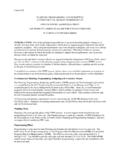Transcription of Appendix II THE BUDGET PROCESS - …
1 Appendix II. THE BUDGET PROCESS . This Appendix provides a summarized description of the BUDGET PROCESS at the national (federal) level. The overall PROCESS has three fundamental phases: formulation; subsequent actions by Congress and the President to provide a legally executable BUDGET ; and actual execution. The entire cycle is a continuum. While the last approved BUDGET is being executed, the next BUDGET is undergoing review and approval in Congress. When passed by Congress and signed by the President, it becomes the BUDGET of the United States for the following fiscal year. Concurrently, formulation of the next BUDGET for submission to Congress is taking place within the departments and agencies. For purposes of this paper, we will focus primarily on formulation and the review and approval aspects of the cycle. The BUDGET of the United States First is a review of the overall PROCESS at the national level, followed by a description of actions within the Department of Defense (DoD) providing the DoD part of the President's BUDGET .
2 From an overall perspective, this PROCESS has a lead time of at least nine months before formal submission to Congress and 18 months before the fiscal year actually begins. In the spring, the President establishes general BUDGET and policy guidelines while the Office of Management and BUDGET (OMB), working with federal departments and agencies, establishes policy directives and levels covering the BUDGET year plus the four following years. The BUDGET calendar for major BUDGET events during the review and approval PROCESS is summarized in the figure below. Most agencies submit BUDGET requests to OMB in the fall, followed by a review of details and resolu- tion of issues. For the Department of Defense, the OMB review is concurrent with the review in the 95. Office of the Secretary of Defense (OSD) during the September-to-December period. By the end of December, all decisions are complete, including issues requiring involvement by the President or other White House policy officials.
3 The BUDGET is then finalized and BUDGET documents prepared. This is now the President's BUDGET . Transmittal to Congress is scheduled by law on or after the first Monday in February of each year. As a practical matter, this has been an early February event, and additional delays sometimes occur in special cases such as a new President. Congress receives the BUDGET proposals and approves, modifies or disapproves them. Through the PROCESS of a BUDGET resolution, it agrees on levels for total spending, receipts and other matters. This resolution provides the framework for congressional committees to prepare the required appropriations bills. In so doing, Congress votes on BUDGET authority the authority to incur legally binding authorizations of the government. In a separate PROCESS , Congress usually enacts legislation that authorizes agencies to carry out particular programs and may limit the amounts that can be appropriated for various programs.
4 Normally, authorizations precede appropriations, but this is not always the case. The Congressional Act of 1994 requires that Congress consider BUDGET totals before completing action on the separate appropriations. To do this, the BUDGET committees formulate a BUDGET resolution setting levels for BUDGET authority, both in total and by functional areas (such as national defense, energy, transportation, etc.). The BUDGET resolution is scheduled for adoption by the whole Congress by April 15, but delays are frequent. This resolution allocates amounts to the appropriations committees that have jurisdiction over the programs, and these committees are required, in turn, to allocate amounts to their respective subcommittees. BUDGET resolutions are not laws and do not require presidential approval. The appropriations committees in both the House and Senate are divided into subcommittees that hold hearings and review detailed BUDGET justification in their jurisdictional areas.
5 Appropriations bills are initiated in the House. After a bill has been approved by the committee and the whole House, it is forwarded to the Senate, where a similar review takes place. When disagreements occur between the two houses of Congress, a conference committee meets to resolve these differences. The report of the conference committee is returned to both houses for approval. It then goes to the President as an enrolled bill for approval or veto. If actions on one or more appropriations bills are not completed by the beginning of the fiscal year (October 1), Congress enacts a continuing resolution to authorize continued operations at some designated level for a specified time, pending a regular appropriation. Continuing resolutions require presidential approval and signature. So far, the actions described pertain to annual appropriations included in 13 separate appropriations bills. These apply to what is described as discretionary spending because of the need for annual BUDGET authority by Congress.
6 While the majority of federal programs are dependent on annual appropriations, the discretionary portion covers only about one-third of annual federal outlays. The rest of federal expenditures come from BUDGET authority in permanent laws which do not need to be reenacted annually. This applies to the large entitlement programs and the interest on the public debt, which are funded by permanent law. Therefore, the majority of outlays in a year are not controlled through separate appropriations actions for the year. The terms used are discretionary for the annual appropriations and direct spending . for those based on permanent laws. Congress may enact new legislation or change existing legislation relating to direct spending, but need take no action on an annual basis, in which case the spending continues in accordance with existing law. Without legislative change, it is on automatic pilot. 96. For more information on the BUDGET PROCESS at the federal level, see A Citizen's Guide to the Federal BUDGET , Fiscal Year 2002 and A Brief Introduction to the Federal BUDGET PROCESS , Congressional Research Report 96-912, updated October 20, 1997.
7 The Department of Defense BUDGET PROCESS Agencies of the government submit and justify BUDGET packages for inclusion in the President's BUDGET . The Department of Defense BUDGET is an important segment of the discretionary funding portion. The DoD BUDGET submitted for inclusion in the President's BUDGET is a product of its Planning, Programming and Budgeting System (PPBS). DoD prepares a Future Years Defense Program (FYDP). spanning six years; the FYDP is periodically updated. The first for the FYDP is the basis for the next BUDGET requiring congressional action. Actually, a two-year BUDGET is prepared in even-numbered years, but Congress acts on only one year at a time, and the second year's BUDGET is updated and resubmitted the following year. The specific calendar of events varies somewhat from year to year, but the basic cycle goes something like this: Defense Fiscal Guidance (DFG) provided in March is followed by revised programs from the services.
8 This is in the form of a Program Objective Memorandum (POM) each service provides to OSD in May or early June. The OSD review leads to a Program Decision Memorandum (PDM) in August/September. In the meantime, budgets for the next fiscal year are being prepared based on OSD guidance and directives. BUDGET Execution Submissions (BESs) are made to OSD by the beginning of October, and the DoD. BUDGET now undergoes a detailed review within OSD. The October-to-December review is actually a joint review by OSD and OMB. Decisions are made through a series of Program Decision Memoranda under supervision of a senior review panel, the Defense Resources Board. After the Secretary of Defense makes final decisions on major issues, the BUDGET is presented to OMB and the President for final review and incorporation into the President's BUDGET . With OMB and presidential approval, the backup documentation for submission to Congress is completed and the DoD BUDGET request (now part of the President's BUDGET ) is delivered in early February.
9 Next comes the congressional justification, review and approval period, ending with the authorization and appropriations bills, passed by Congress and signed by the President. Ideally, all this is completed by the beginning of the fiscal year on October 1. If not, operations continue with an appropriate Continuing Resolution. A schematic of the basic flow is shown in the figure on page 98. After a series of hearings, Congress provides both authorization and appropriations bills. While authorization is important for program approvals, it is the appropriations bills that provide DoD with the authority to obligate funds and make payments (outlays) against these obligations. Appropriations for the Department of Defense are covered by two separate bills: the Military Construction Appropriations Bill, which addresses Military Construction and Family Housing, and the Department of Defense Appropriations Bill for all other DoD appropriations.
10 These bills incorporate a number of individual appropriations covering Military Personnel, Operation and Maintenance, Procure- ment, RDT&E (Research, Development, Test and Evaluation), Military Construction and Family Housing. They are identified in the appropriations bills by title and military service. At the start of the new fiscal year, providing the bills are passed and signed by the President, the exe- cution phase begins. Before funds can be obligated, however, OMB must apportion the funds to DoD and Treasury warrants must be issued. DoD, in turn, subapportions for further allocation to operating agencies. 97. The services play a subordinate role to DoD in all of this, in both the formulation and justification of their respective portions of the DoD BUDGET . All the services conform to the same calendar and procedures with respect to the DoD BUDGET PROCESS . At any one time a number of concurrent actions involving different budgets are occurring.









